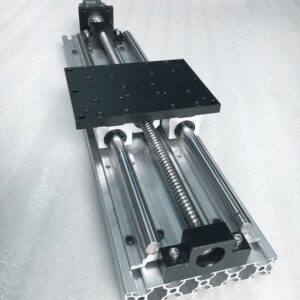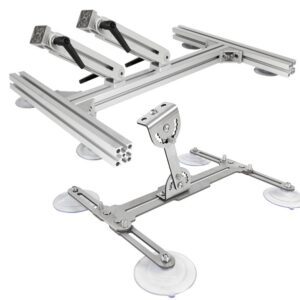Linear motion lies at the heart of modern machinery — from CNC machines to robotics and automation systems. Among the most efficient solutions for achieving controlled, smooth, and precise movement is the linear sliding rail. This mechanical component ensures that motion occurs along a straight, friction-minimized path, transforming raw mechanical energy into predictable, repeatable results.
In this comprehensive guide, we’ll explore everything you need to know about linear sliding rails — their design, working mechanism, benefits, limitations, and applications. Whether you’re an engineer, hobbyist, or manufacturer, understanding this technology can elevate your project’s precision, reliability, and longevity.
Understanding Linear Sliding Rail
A linear sliding rail is a mechanical guide that enables motion along a straight path. It consists of two main parts — a fixed rail and a slider or carriage that moves along it. The rail defines the travel path, while the carriage carries the load or equipment that needs to move.
Unlike traditional sliding mechanisms that rely on direct surface contact (which causes friction and wear), linear sliding rails often incorporate rolling elements like ball bearings or rollers. These elements minimize friction, enhance precision, and improve load-bearing capacity.
The principle is straightforward: convert rotary motion (from a motor or actuator) into linear movement with minimal frictional losses. The result? Smoother motion, improved efficiency, and extended component life.
Main Components of a Linear Sliding Rail
To appreciate the system’s performance, it’s vital to understand its main components and their roles:
Rail (Guide Track):
The hardened and precision-machined base that defines the linear path. Rails are usually made of steel, stainless steel, or aluminum, depending on the application’s load and environment.Carriage (Slider or Block):
The moving element that rides on the rail. It supports the load and ensures smooth motion. Depending on design, it may hold ball bearings, rollers, or sliding pads.Rolling Elements:
Bearings or rollers that reduce friction between the rail and carriage. These can be recirculating balls, cylindrical rollers, or needle bearings.End Caps and Seals:
These components prevent contamination by dust, chips, or moisture, keeping the internal surfaces clean and lubricated.Lubrication System:
Ensures consistent lubrication of the moving parts, reducing wear and extending service life.
Working Principle of Linear Sliding Rail
The operation of a linear sliding rail relies on controlled rolling or sliding contact. When an external force (like a motor-driven actuator) applies motion to the carriage, it glides along the rail. If the rail uses ball bearings or rollers, these elements circulate inside the carriage, maintaining smooth motion and distributing the load evenly.
The result is a nearly frictionless motion — allowing for high accuracy, speed, and load capacity with minimal wear and energy loss.
Types of Linear Sliding Rails
Linear sliding rails come in different configurations to meet diverse industrial needs. Here are the most common types:
Profiled Linear Rail (Ball Type)
This is the most widely used type. The carriage houses recirculating ball bearings that roll along precision-ground raceways in the rail. It offers high rigidity, load capacity, and precision, making it ideal for CNC machines and industrial robots.
Crossed Roller Rail
Instead of ball bearings, this rail uses crossed cylindrical rollers positioned at 90 degrees to one another. It delivers ultra-smooth motion with exceptional rigidity and is often used in optical inspection and semiconductor equipment.
Round Shaft Rail
A simpler design where the carriage rides on a cylindrical shaft. It’s cost-effective and easier to align, but offers less rigidity and precision than profiled rails. Commonly used in light-duty applications and automation setups.
Dovetail Slide Rail
This type features a V-shaped or dovetail interface. It provides excellent load-carrying capability and vibration damping. Though not as smooth as rolling-element rails, it’s durable and suitable for environments with heavy debris.
Telescopic Sliding Rail
Designed for applications requiring extendable motion, such as drawers or machine enclosures. It consists of multiple sliding sections that expand and retract smoothly.
Advantages of Linear Sliding Rail
Choosing a linear sliding rail provides multiple engineering and operational benefits:
High Precision and Accuracy:
Provides smooth and consistent motion for applications requiring exact positioning.Low Friction and Energy Efficiency:
Rolling contact significantly reduces friction, resulting in lower energy consumption and minimal wear.High Load Capacity:
Capable of supporting heavy vertical and horizontal loads without sacrificing stability or motion quality.Durability and Longevity:
Hardened materials and lubrication systems extend operational life even in demanding environments.Smooth and Quiet Operation:
Optimized bearing design ensures low noise and minimal vibration — critical for laboratory and medical applications.Maintenance Efficiency:
Sealed designs reduce contamination risks, while integrated lubrication simplifies maintenance.
Limitations of Linear Sliding Rail
While linear sliding rails are highly effective, they’re not without challenges:
Cost:
High-precision models can be expensive, particularly when specialized coatings or materials are required.Installation Sensitivity:
Misalignment during installation can cause uneven wear, noise, or even failure. Proper alignment is essential.Lubrication Needs:
Though lubrication extends life, neglecting it leads to increased friction and damage.Environmental Limitations:
Exposure to dust, corrosive chemicals, or moisture can impair performance unless properly sealed or treated.
Applications of Linear Sliding Rail
Linear sliding rails are ubiquitous across industries due to their adaptability and precision. Key applications include:
CNC Machines and Milling Equipment:
For precise linear motion of cutting tools or work tables.3D Printers and Laser Cutters:
Ensures smooth, accurate motion of print heads and laser modules.Robotics and Automation:
Guides robotic arms and assembly systems with minimal play and maximum repeatability.Medical Equipment:
Used in imaging systems, surgical robots, and diagnostic devices where reliability and accuracy are critical.Packaging and Printing:
Provides fast, consistent movement for labeling, sorting, and printing operations.Industrial Conveyors:
Enables smooth transport of goods with precise alignment.
Factors to Consider When Selecting a Linear Sliding Rail
Selecting the right linear sliding rail depends on several performance and environmental factors:
Load and Force Requirements:
Consider both static and dynamic loads, as well as lateral forces and torque.Speed and Acceleration:
High-speed operations require lower friction and superior lubrication.Precision Level:
Determine whether your application needs micrometer-level accuracy or general smooth motion.Environmental Conditions:
Choose corrosion-resistant materials for humid or chemical-prone environments.Material Choice:
Steel for high strength, aluminum for lightweight setups, and stainless steel for corrosion resistance.Mounting Surface Quality:
Poor alignment or uneven mounting surfaces can severely affect performance and lifespan.Maintenance and Lubrication:
Evaluate how accessible lubrication points are and whether the system is self-lubricating.
Maintenance Best Practices for Linear Sliding Rails
To ensure long-term performance and reliability, follow these maintenance tips:
Keep the rails clean from dust, chips, and moisture.
Reapply lubrication periodically based on manufacturer guidelines.
Inspect bearings and seals regularly for wear or damage.
Avoid overloading the system beyond rated capacity.
Maintain proper alignment during any mechanical adjustments.
Routine preventive care can extend the rail’s lifespan and maintain accuracy over years of operation.

Future Innovations in Linear Sliding Rail Systems
The evolution of linear motion technology continues with innovations such as:
Self-Lubricating Rails: Advanced polymers and coatings reduce or eliminate the need for external lubrication.
Smart Linear Systems: Integrated sensors monitor load, vibration, and lubrication levels in real time.
Lightweight Materials: Aluminum and carbon fiber rails reduce weight while maintaining strength.
Hybrid Sliding Mechanisms: Combining magnetic levitation with traditional rails for near-frictionless motion.
Such innovations are setting new standards in efficiency, speed, and durability.
Linear Sliding Rail
In essence, a linear sliding rail is more than a guiding component — it’s the backbone of mechanical precision. By providing smooth, stable, and predictable linear movement, it transforms how machines perform repetitive or delicate tasks. Whether used in an industrial robot or a precision optical instrument, the rail ensures accuracy, reliability, and efficiency that traditional mechanisms can’t match.
Frequently Asked Questions
What is a linear sliding rail used for?
A linear sliding rail is used to provide smooth and accurate linear motion in machines such as CNC equipment, 3D printers, and automation systems.
What materials are commonly used for linear rails?
Steel, stainless steel, and aluminum are most common, chosen for their strength, corrosion resistance, and weight.
How often should a linear sliding rail be lubricated?
Lubrication intervals depend on operating conditions but typically range from every few hundred to a few thousand operating hours.
What causes wear in linear rails?
Wear is mainly caused by contamination, misalignment, or insufficient lubrication.
Can linear sliding rails operate vertically?
Yes, many rails are designed for vertical or multi-axis applications, provided they’re properly supported.
What’s the difference between a linear rail and a linear bearing?
A linear rail provides the guiding path, while the linear bearing or carriage enables the smooth movement along that path.
Conclusion
The linear sliding rail stands as one of the most versatile and dependable components in precision engineering. Its ability to handle high loads, maintain smooth motion, and deliver unmatched accuracy has made it indispensable in industrial automation, robotics, and manufacturing. When selected, installed, and maintained properly, it ensures years of efficient, silent, and precise operation — a true cornerstone of modern motion control.
Inbound Link Suggestions:
[Precision Engineering Fundamentals]
[Industrial Automation Systems Overview]
[How CNC Machines Work]
Outbound Link Suggestions:
Manufacturer technical data sheets for linear rails
Engineering motion control standards
Research papers on friction-reduction mechanisms



